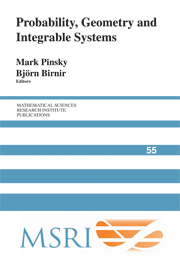Book contents
- Frontmatter
- Contents
- Preface
- Henry McKean: A tribute by the editors
- Bitangential direct and inverse problems for systems of differential equations
- Turbulence of a unidirectional flow
- Riemann–Hilbert problem in the inverse scattering for the Camassa–Holm equation on the line
- The Riccati map in random Schrödinger and random matrix theory
- SLE6and CLE6 from critical percolation
- Global optimization, the Gaussian ensemble, and universal ensemble equivalence
- Stochastic evolution of inviscid Burgers fluid
- A quick derivation of the loop equations for random matrices
- Singular solutions for geodesic flows of Vlasov moments
- Reality problems in the soliton theory
- Random walks and orthogonal polynomials: some challenges
- Integration of pair flows of the Camassa–Holm hierarchy
- Landen Survey
- Lines on abelian varieties
- Integrable models of waves in shallow water
- Nonintersecting Brownian motions, integrable systems and orthogonal polynomials
- Homogenization of random Hamilton–Jacobi–Bellman Equations
Reality problems in the soliton theory
Published online by Cambridge University Press: 27 June 2025
- Frontmatter
- Contents
- Preface
- Henry McKean: A tribute by the editors
- Bitangential direct and inverse problems for systems of differential equations
- Turbulence of a unidirectional flow
- Riemann–Hilbert problem in the inverse scattering for the Camassa–Holm equation on the line
- The Riccati map in random Schrödinger and random matrix theory
- SLE6and CLE6 from critical percolation
- Global optimization, the Gaussian ensemble, and universal ensemble equivalence
- Stochastic evolution of inviscid Burgers fluid
- A quick derivation of the loop equations for random matrices
- Singular solutions for geodesic flows of Vlasov moments
- Reality problems in the soliton theory
- Random walks and orthogonal polynomials: some challenges
- Integration of pair flows of the Camassa–Holm hierarchy
- Landen Survey
- Lines on abelian varieties
- Integrable models of waves in shallow water
- Nonintersecting Brownian motions, integrable systems and orthogonal polynomials
- Homogenization of random Hamilton–Jacobi–Bellman Equations
Summary
This is a survey article dedicated mostly to the theory of real regular finite-gap (algebro-geometrical) periodic and quasiperiodic sine-Gordon solutions. Long period this theory remained unfinished and ineffective, and by that reason practically had no applications. Even for such simple physical quantity as topological charge no formulas existed expressing it through inverse spectral data. A few years ago the present authors solved this problem and made this theory effective. This article contains description of the history and recent achievements. It describes also the reality problems for several other fundamental soliton systems.
1. Introduction
The most powerful method for constructing explicit periodic and quasiperiodic solutions of soliton equations is based on the finite-gap or algebro-geometric approach, developed by Novikov [1974], Dubrovin et al. [1976b], Its and Matveev [1975], Lax [1975], and McKean and van Moerbeke [1975] for 1+1 systems, and extended by Krichever in 1976 for 2+1 systems like KP. Already in 1976 new ideas were formulated on how to extend this approach to the 2 + 1 systems associated with the spectral theory of the 2D Schr¨odinger operator restricted to one energy level; see [Manakov 1976; Dubrovin et al. 1976a]. These ideas were developed in 1980s by several people in Moscow's Novikov Seminar, as discussed see below. The “spectral data” characterizing the associated Lax-type operators consist of a Riemann surface (spectral curve) equipped with a selected set of points (divisor of poles, infinities). In the finite gap case this Riemann surface has finite genus, and the number of selected point is also finite.
Information
- Type
- Chapter
- Information
- Probability, Geometry and Integrable Systems , pp. 221 - 240Publisher: Cambridge University PressPrint publication year: 2008
